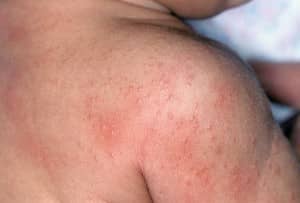 Here at Neocate, we often talk with concerned parents who tell us they’ve read other stories from parents whose children had a terrible rash that was only helped by Neocate after lots of trial and error. Frequently, these parents tell us they don’t feel their doctor is familiar with food allergies. Just yesterday a father told me that his pediatrician kept telling him that “every baby gets rashes, it’s normal; he’ll grow out of it.”
Here at Neocate, we often talk with concerned parents who tell us they’ve read other stories from parents whose children had a terrible rash that was only helped by Neocate after lots of trial and error. Frequently, these parents tell us they don’t feel their doctor is familiar with food allergies. Just yesterday a father told me that his pediatrician kept telling him that “every baby gets rashes, it’s normal; he’ll grow out of it.”
Many parents who eventually learn that their child has a food allergy, which can only be treated by changing the diet, wish their journey to a solution had been shorter and simpler. Here are some tips for what you can do if you feel your doctor isn’t recognizing your little one’s rash as a possible sign of a food allergy.
Take Careful Notes
A rash is often the first sign of a food allergy that a parent notices. While it’s true that almost all babies experience diaper rash at some point, this is not the same as a rash caused by food allergy. Diaper rash, like many rashes, is caused by something on the outside: wet or rubbing diapers, scented lotion, rough fabrics, or even fabric softener. It’s important to rule out these other causes that might contribute to eczema, atopic dermatitis, or itching.
If you’ve eliminated potential causes, it’s more likely that the rash is caused by something on the inside: a food allergen. If you document all steps you’ve taken to eliminate other culprits, the doctor is more likely to consider a food allergy as the cause of your baby’s rash. If you notice that your baby has a rash and you think it might be related to a food allergy, check to see if your baby exhibits any other signs of a food allergy. It’s unusual for a baby with food allergy to only have a rash. Make a list of your baby’s symptoms which could also be caused by a food allergy to provide to the doctor.
Many parents tell us that they went through multiple different infant formulas before finally finding relief with Neocate. Some infants don’t even tolerate breast milk because of dairy foods in the mom’s diet. Make notes of the different symptoms that did not go away with each formula you’ve tried. Many doctors assume a soy formula or hydrolyzed formula will help if the baby has a milk allergy. However, many babies with a milk allergy also have a soy allergy and can be extremely sensitive to even small amounts of milk protein.
Make an Appointment with Your Baby’s Doctor
When you discuss your baby’s rash with the pediatrician, explain that you think you have ruled out other causes, and explain the list of changes you tried that did not help. Inform the doctor that food allergy is common among infants, and explain the other symptoms your child is experiencing which could be related to food allergy. Skin creams are commonly prescribed for rashes. While these creams may help to reduce inflammation and itching caused by a food allergy, they will not help other allergy symptoms such as diarrhea, gastroesophageal reflux disease (GERD), or wheezing. Only a change in the diet will truly solve the problem.
When you see your pediatrician, you may also want to request a referral to an allergist (narrow your search by selecting the “Food Allergy” specialty). The allergy testing that these professionals perform provides the best information to help your child find a diagnosis and relief from a food allergy.
Finally, share with the doctor your knowledge of Neocate, the amino acid-based formula that makes such a difference for babies with food allergies. It’s important to follow the steps to help give your baby’s rash the best chance to heal. We know that it is so hard to see your little one feeling so uncomfortable but remember it may take some time, even after you start using Neocate.
What steps did you take to know that your baby’s rash was caused by food allergy?
–






